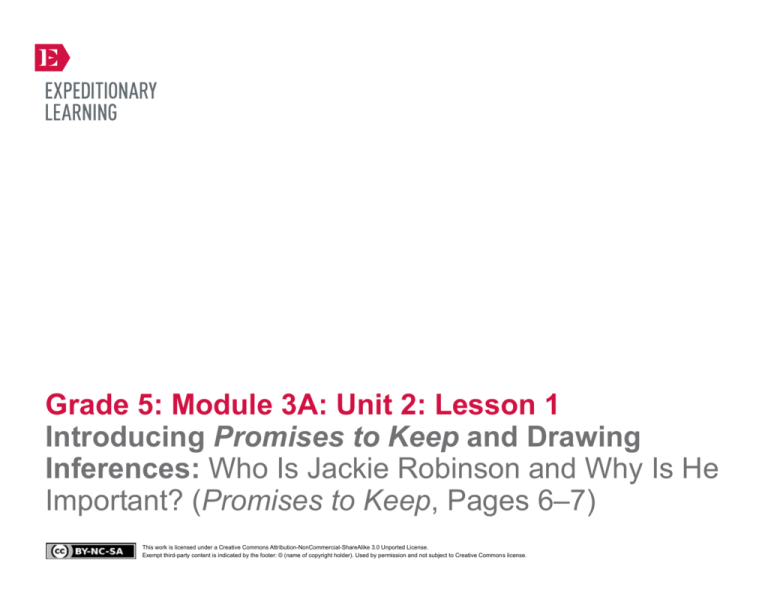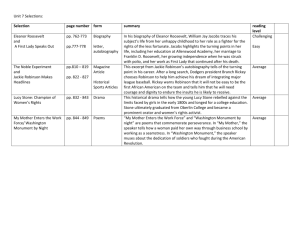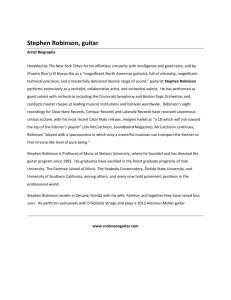
Grade 5: Module 3A: Unit 2: Lesson 1
Introducing Promises to Keep and Drawing
Inferences: Who Is Jackie Robinson and Why Is He
Important? (Promises to Keep, Pages 6–7)
This work is licensed under a Creative Commons Attribution-NonCommercial-ShareAlike 3.0 Unported License.
Exempt third-party content is indicated by the footer: © (name of copyright holder). Used by permission and not subject to Creative Commons license.
GRADE 5: MODULE 3A: UNIT 2: LESSON 1
Introducing Promises to Keep and Drawing Inferences:
Who Is Jackie Robinson and Why Is He Important?
(Promises to Keep, Pages 6–7)
Long-Term Targets Addressed (Based on NYSP12 ELA CCLS)
I can explain what a text says using quotes from the text. (RI.5.1)
I can make inferences using quotes from the text. (RI.5.1)
I can determine the main idea(s) of an informational text based on key details. (RI.5.2)
I can determine the meaning of academic words or phrases in an informational text. (RI.5.4)
I can determine the meaning of content words or phrases in an informational text. (RI.5.4)
I can summarize text that is read aloud to me. (SL.5.2)
Supporting Learning Targets
Ongoing Assessment
• I can describe the features of a biographical text.
• Notice/Wonder/Inference note-catcher
• I can draw inferences about Jackie Robinson from the photographs in the Introduction to Promises to
Keep.
• Gist statement
• I can determine the meaning of new words and phrases from context in Promises to Keep.
• Sticky note evidence flags
Copyright © 2013 by Expeditionary Learning, New York, NY. All Rights Reserved.
• Vocabulary cards
NYS Common Core ELA Curriculum • G5:M3A:U2:L1 • June 2014 •
1
GRADE 5: MODULE 3A: UNIT 2: LESSON 1
Introducing Promises to Keep and Drawing Inferences:
Who Is Jackie Robinson and Why Is He Important?
(Promises to Keep, Pages 6–7)
Agenda
Teaching Notes
1. Opening
• This lesson introduces Promises to Keep, the central text the class will read throughout Unit 2. The book
affords many opportunities for close reading lessons based on determining how an author uses reasons
and evidence (to be introduced in Lesson 2) to support a point or opinion. This first lesson orients
students to the book by “reading” the pictures and studying the Introduction.
A. Biography as Informational Text (10 minutes)
2. Work Time
A. Picture Walk through Promises to Keep (10 minutes)
B. Building Background Knowledge: Reading the
Introduction of Promises to Keep (25 minutes)
C. Key Vocabulary to Deepen Understanding (10
minutes)
3. Closing and Assessment
A. Debrief and Review Learning Targets (5 minutes)
4. Homework
A. Reread the Introduction to Promises to Keep on your
own or aloud to someone at home. Answer
homework questions on index cards.
Copyright © 2013 by Expeditionary Learning, New York, NY. All Rights Reserved.
• Throughout this unit, the terms “African American” and “black(s)” are used interchangeably. The
language of the lessons reflects the terminology author Sharon Robinson uses within the text Promises
to Keep.
• Students continue to use their journals from Unit 1 for Units 2 and 3.
• In advance: Intentionally place students in groups of four. Students will remain in these groups
throughout Unit 2. Be sure to heterogeneously group students so that stronger readers and writers are
with students who have difficulty reading complex text.
• In advance: List vocabulary words, along with the page number from the text for each, on the board or a
piece of chart paper.
• Post: Learning targets.
NYS Common Core ELA Curriculum • G5:M3A:U2:L1 • June 2014 •
2
GRADE 5: MODULE 3A: UNIT 2: LESSON 1
Introducing Promises to Keep and Drawing Inferences:
Who Is Jackie Robinson and Why Is He Important?
(Promises to Keep, Pages 6–7)
Lesson Vocabulary
Materials
notice, wonders, inferences (from
Modules 1 and 2A), biography,
biographical, introduction;
accomplishments, legacy,
determination, commitment
• Document camera
• Types of Informational Text anchor chart (from Module 2A, Unit 1, Lessons 1 and 2)
• Features of Informational Text anchor chart (from Module 2A, Unit 1, Lessons 1 and 2)
• Promises to Keep (book; one per student and one for display)
• Notice/Wonder/Inference note-catcher (one for display)
• Students’ journals (from Unit 1)
• Index cards (eight per student)
• Vocabulary Strategies anchor chart (from Unit 1, Lesson 1)
Copyright © 2013 by Expeditionary Learning, New York, NY. All Rights Reserved.
NYS Common Core ELA Curriculum • G5:M3A:U2:L1 • June 2014 •
3
GRADE 5: MODULE 3A: UNIT 2: LESSON 1
Introducing Promises to Keep and Drawing Inferences:
Who Is Jackie Robinson and Why Is He Important?
(Promises to Keep, Pages 6–7)
Opening
Meeting Students’ Needs
A. Biography as Informational Text (10 minutes)
• Using a document camera, display the Types of Informational Text anchor chart and Features of
Informational Text anchor chart, both from Module 2A. If biography is not already listed, add it to both charts.
• Students may benefit from a mini
lesson or review on word types (e.g.,
nouns, verbs, adjectives, adverbs),
followed by a word study of types of
words using the vocabulary words
taught from Promises to Keep.
• Ask students to think and then talk with a partner about the definition of this word. Invite a volunteer to share out. Listen
for answers that include key elements such as: “about a person’s life,” “true but told like a story,” “about a famous person,”
etc. Ask students where they recently saw the prefix “bio-” and look for them to remember the word biodiversity from their
study of the rainforest (Module 2A). Remind them that the word root “bio” means life. Tell them that the root graph means
“to write,” so biography means to write about someone’s “life.” Continue to reinforce the skill of using word roots to
determine word meanings. Help students understand that biographical is the adjective form of biography. Ask students to
give examples of other biographies they may have read.
• Draw pictures to represent key
words in the learning target (e.g., a
book for text, a stick figure of a
person for bio.) Providing visual
cues to learning targets can help
students understand unknown
words or concepts.
• Read the first learning target:
* “I can describe the features of a biographical text.”
• Focus students on the Features of Informational Text anchor chart. Add biography to the left-hand column. Ask them to
think about the features of a biography. Invite volunteers to share out. Listen for responses such as: “A narrative, like a story,
has a lot of details about a person’s life and times,” “It’s told in chronological order,” “It includes pictures of the person at
different ages,” etc. Add these to the center column (Features/Elements).
• Then focus students on the right-hand column: How Does It Help the Reader? Ask students to discuss with a partner how
these features may help them read and understand the text. Listen for responses such as: “It’s written like a story so it’s easy
to follow,” “I like hearing about their childhood,” or “The photos are interesting.” Invite a few partners to share out and add
these ideas to the third column of the anchor chart.
Copyright © 2013 by Expeditionary Learning, New York, NY. All Rights Reserved.
NYS Common Core ELA Curriculum • G5:M3A:U2:L1 • June 2014 •
4
GRADE 5: MODULE 3A: UNIT 2: LESSON 1
Introducing Promises to Keep and Drawing Inferences:
Who Is Jackie Robinson and Why Is He Important?
(Promises to Keep, Pages 6–7)
Work Time
Meeting Students’ Needs
A. Picture Walk through Promises to Keep (10 minutes)
• Provide copies of Promises to Keep
for ELL students in their home
languages.
• Enthusiastically introduce students to Promises to Keep, the book they will be reading together for the next few weeks.
Hold up a copy of the book for the class to see, and say:
* “This book is Promises to Keep: How Jackie Robinson Changed America by Sharon Robinson. What kind of book do you
think it is?” (Answer: A biography.)
* “What features do you predict it will have?” (Answers might include: a narrative structure; details about Jackie Robinson
and his times; or information about his childhood.)
• Direct students’ attention to the second learning target:
* “I can draw inferences about Jackie Robinson from the photographs in the Introduction to Promises to Keep.”
• Display the Notice/Wonder/Inference note-catcher. Instruct students to take out their students’ journals and to
draw the same three-column chart on the next clean page. Check that students remember that notices are what we see and
hear directly, inferences are ideas we have based on what we see and hear, and wonders are questions.
• Distribute Promises to Keep to the students. Ask them to look at just the front cover, and to record in their note-catchers
what they notice, wonder about, and infer from just this picture and the text on the cover.
• After a few minutes, have students spread their books open, face down, so they can see the front and back covers are visible
as one large photograph. Invite them to enter any additional thoughts in their note-catchers.
• Invite students to turn and share their notes with a partner. Circulate, listening for thoughts such as:
• Provide copies of the Notice/
Wonder/Inference chart for
students who may have difficulty
copying it into their journal.
• Consider charting students’
comments on a class Notice/
Wonder/Inference anchor chart to
keep posted throughout Unit 2.
• Provide sentence stems for students
who may have difficulty with
language: “I noticed that
__________________. A text
feature that is important in this
book is ______________.”
* Notices: “There’s a man, a woman, and three children,” or “The man looks like he’s pointing at something, the author’s
last name is Robinson.”
* Wonders: “Is the author related to Jackie Robinson?” or “How old is this picture?”
* Inferences: “I think it’s a family,” “I think the picture was taken a long time ago,” or “I think that man is Jackie Robinson.”
• Tell students that next they will do a Picture Walk through the book. Ask them to page through the book, looking at the
pictures and continuing to notice, wonder, and draw inferences from the pictures. Give students 5–7 minutes for their silent
Picture Walk.
• Again ask students to share what they noticed, inferred, and wondered. Listen to make sure that students understand the
distinction between observable data and inferences based on the data.
• Ask students what the photographs and captions in a book are called (text features), and why they are important in this
book. Listen for answers that indicate understanding that in this book the photographs of people and artifacts tell much of
the story.
Copyright © 2013 by Expeditionary Learning, New York, NY. All Rights Reserved.
NYS Common Core ELA Curriculum • G5:M3A:U2:L1 • June 2014 •
5
GRADE 5: MODULE 3A: UNIT 2: LESSON 1
Introducing Promises to Keep and Drawing Inferences:
Who Is Jackie Robinson and Why Is He Important?
(Promises to Keep, Pages 6–7)
Work Time (continued)
Meeting Students’ Needs
B. Building Background Knowledge: Reading the Introduction of Promises to Keep (25 minutes)
• Consider grouping students at
tables strategically so that stronger
readers and writers are at tables
with those students who struggle
with grade-level text so peers may
support one another during group
reads and discussions.
• Tell students that they will be in groups of four during this unit as they work with this text. Place students in their groups
and invite them to turn to the Introduction in Promises to Keep (page 6).
• Ask students for the meaning of the word introduction, and listen for answers such as: “beginning.” Be sure they mention
the connection to the word introduce. Listen for comments such as: “Introduction has the suffix -tion added to the word
introduce. Introduce is a verb, and introduction is a noun.” Reinforce using word roots to determine word meaning.
• Tell students that they will now read the Introduction to the book. Read pages 6 and 7 of Promises to Keep aloud as students
read along silently in their heads.
• Give students a few minutes to talk in their groups about the gist of the Introduction. Then ask them to write a gist statement
on the next page of their journals.
• To support visual learners, chart
students’ comments on a class
Notice/Wonder/Inference chart.
• Cold call several students to share their thinking with the whole group. Listen for ideas such as: “Jackie Robinson was a
great baseball player and a great man,” and “Sharon Robinson, Jackie Robinson’s daughter, wrote this book because she
loved and admired her dad very much.”
• Give students time to reread the Introduction on their own. Direct them to record additional notes in their Notice/
Wonder/Inference note-catchers.
• Circulate around the classroom as they work, ensuring that students are recording notes such as the following:
* Notice: “The author of the book, Sharon Robinson, is Jackie Robinson’s daughter,” or “Jackie Robinson was elected into
the Baseball Hall of Fame.”
* Wonder: “Why did Jackie Robinson retire from baseball when Sharon was six?” or “Why is Jackie Robinson so famous?”
* Inference: “Sharon Robinson loved her dad,” or “Jackie Robinson was a great man.”
• Cold call on a few students to share their answers with the whole class. Collect journals to review.
Copyright © 2013 by Expeditionary Learning, New York, NY. All Rights Reserved.
NYS Common Core ELA Curriculum • G5:M3A:U2:L1 • June 2014 •
6
GRADE 5: MODULE 3A: UNIT 2: LESSON 1
Introducing Promises to Keep and Drawing Inferences:
Who Is Jackie Robinson and Why Is He Important?
(Promises to Keep, Pages 6–7)
Work Time (continued)
Meeting Students’ Needs
C. Key Vocabulary to Deepen Understanding (10 minutes)
• Read the third learning target:
• Highlight the focus vocabulary in
the text for students who may have
difficulty locating them on their
own.
* “I can determine the meaning of new words and phrases from Promises to Keep.”
• Ask students to locate the following words in the Introduction:
• Consider prewriting the vocabulary
words on the cards for students who
struggle with writing.
– accomplishments (page 6, Paragraph 2, Line 1)
– legacy (page 6, Paragraph 2, Lines 2 and 3)
– determination (page 7, first full paragraph, Line 9)
– commitment (page 7, Paragraph 4, Line 6)
• Distribute four index cards to each student and tell them to write one of these words on each card. Refer to the
Vocabulary Strategies anchor chart (from Unit 1, Lesson 1 of this module), and ask students to use the strategy of
reading the sentences around these words to try to figure out their meanings from context clues. Then have them turn and
talk with a neighbor about the meanings.
• Consider providing additional time
to complete vocabulary cards at
different parts during the day.
• Finally, cold call students to share their definitions with the class. Correct misunderstandings and write the accurate
definitions on the white board as the students supply them:
– accomplishments: achievements
– legacy: something (either good or bad) that is handed down from the past
– determination: extreme drive to do or accomplish something
– commitment: a sense of loyalty or strong belief in an idea
• Ask students to draw a picture for each to show what the words mean and write the definitions on the backs of the cards.
• Point out that these words will be particularly important to understand Jackie Robinson’s life.
Copyright © 2013 by Expeditionary Learning, New York, NY. All Rights Reserved.
NYS Common Core ELA Curriculum • G5:M3A:U2:L1 • June 2014 •
7
GRADE 5: MODULE 3A: UNIT 2: LESSON 1
Introducing Promises to Keep and Drawing Inferences:
Who Is Jackie Robinson and Why Is He Important?
(Promises to Keep, Pages 6–7)
Closing and Assessment
Meeting Students’ Needs
A. Debrief and Review Learning Targets (5 minutes)
• Provide framework options for
students to choose from to provide
evidence.: “One thing I was able to
infer about Jackie Robinson was
_______________.” “Some of
the text features in the book
Promises to Keep are
________________________.”
“I was able to figure out the
meaning of the word
_____________________.”
• Review the learning targets. Ask students to think of one piece of evidence that indicates that they met one of the learning
targets, and to share their thought with a neighbor. Ask a few students to share their neighbor’s idea with the class.
• Give each student four index cards for their homework.
Homework
Meeting Students’ Needs
• Reread the Introduction to Promises to Keep on your own or aloud to someone at home.
• Provide an audio recording of
Promises to Keep for students who
struggle with reading grade-level
text.
• On one of your index cards, write an answer to the question: “What does Sharon Robinson admire about her father, Jackie
Robinson?” Name at least three things and use at least one of today’s vocabulary words in your answer.
• On three new index cards, record these three words: biography, biographical, introduction.
• On the back of each index card, draw a picture to show what the word means AND write a definition for the word.
• Bring your four index cards as an admit ticket to the next class.
• Consider prewriting the focus
question for the rereading and the
vocabulary words on index cards for
students who struggle with writing.
• Students who struggle with
language may need to dictate the
answer to their focus question and
the definitions of their vocabulary
words to someone at home.
Copyright © 2013 by Expeditionary Learning, New York, NY. All Rights Reserved.
NYS Common Core ELA Curriculum • G5:M3A:U2:L1 • June 2014 •
8
Grade 5: Module 3A: Unit 2: Lesson 1
Supporting Materials
This work is licensed under a Creative Commons Attribution-NonCommercial-ShareAlike 3.0 Unported License.
Exempt third-party content is indicated by the footer: © (name of copyright holder). Used by permission and not subject to Creative Commons license.
GRADE 5: MODULE 3A: UNIT 2: LESSON 1
Notice/Wonder/Inference Note-catcher
Notice
Wonder
Copyright © 2013 by Expeditionary Learning, New York, NY. All Rights
Reserved..
Inference
NYS Common Core ELA Curriculum • G5:M3A:U2:L1 • June 2014 •
10







